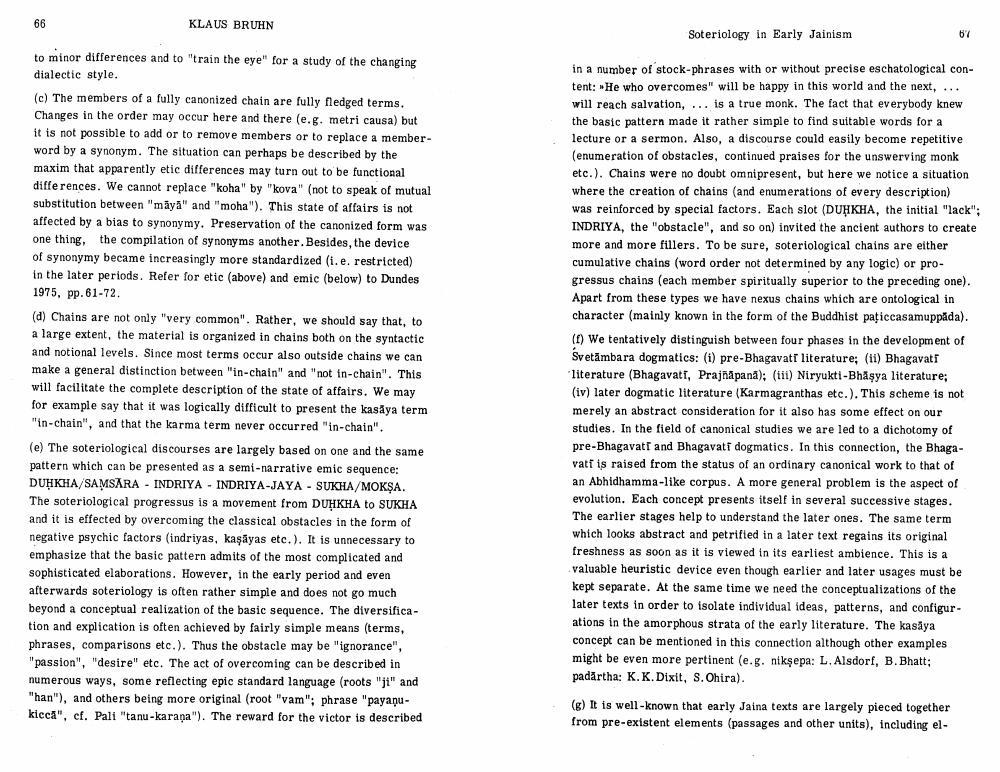________________
KLAUS BRUHN
Soteriology in Early Jainism
to minor differences and to "train the eye" for a study of the changing dialectic style. (c) The members of a fully canonized chain are fully fledged terms. Changes in the order may occur here and there (e.g. metri causa) but it is not possible to add or to remove members or to replace a memberword by a synonym. The situation can perhaps be described by the maxim that apparently etic differences may turn out to be functional differences. We cannot replace "Koha" by "kova" (not to speak of mutual substitution between "maya" and "moha"). This state of affairs is not affected by a bias to synonymy. Preservation of the canonized form was one thing, the compilation of synonyms another. Besides, the device of synonymy became increasingly more standardized (1.e. restricted) in the later periods. Reler for etic (above) and emic (below) to Dundes 1975, pp. 61-72. (d) Chains are not only "very common". Rather, we should say that, to a large extent, the material is organized in chains both on the syntactic and notional levels. Since most terms occur also outside chains we can make a general distinction between "in-chain" and "not in-chain". This will facilitate the complete description of the state of affairs. We may for example say that it was logically difficult to present the kasaya term "in-chain", and that the karma term never occurred "in-chain".
in a number of stock-phrases with or without precise eschatological content: He who overcomes" will be happy in this world and the next, ... will reach salvation, ... is a true monk. The fact that everybody knew the basic pattern made it rather simple to find suitable words for a lecture or a sermon. Also, a discourse could easily become repetitive (enumeration of obstacles, continued praises for the unswerving monk etc.). Chains were no doubt omnipresent, but here we notice a situation where the creation of chains (and enumerations of every description) was reinforced by special factors. Each slot (DUHKHA, the initial "lack": INDRIYA, the "obstacle", and so on) invited the ancient authors to create more and more fillers. To be sure, soteriological chains are either cumulative chains (word order not determined by any logic) or progressus chains (each member spiritually superior to the preceding one). Apart from these types we have nexus chains which are ontologica character (mainly known in the form of the Buddhist paticcasamuppada).
(e) The soteriological discourses are largely based on one and the same pattern which can be presented as a semi-narrative emic sequence: DUŇKHA/SAMSARA - INDRIYA - INDRIYA-JAYA - SUKHA/MOKŞA. The soteriological progressus is a movement from DUŇKHA to SUKHA and it is effected by overcoming the classical obstacles in the form of negative psychic factors (indriyas, kaşayas etc.). It is unnecessary to emphasize that the basic pattern admits of the most complicated and sophisticated elaborations. However, in the early period and even afterwards soteriology is often rather simple and does not go much beyond a conceptual realization of the basic sequence. The diversification and explication is often achieved by fairly simple means (terms, phrases, comparisons etc.). Thus the obstacle may be "ignorance", "passion", "desire" etc. The act of overcoming can be described in numerous ways, some reflecting epic standard language (roots "11" and "han"), and others being more original (root "vam"; phrase "payapukicca", cf. Pali "tanu - karana"). The reward for the victor is described
(1) We tentatively distinguish between four phases in the development of Svetambara dogmatics: (i) pre-Bhagavatt literature; (ii) Bhagavat literature (Bhagavati, Prajñāpanā); (til) Niryukti-Bhāşya literature; (iv) later dogmatic literature (Karmagranthas etc.). This schem merely an abstract consideration for it also has some effect on our studies. In the field of canonical studies we are led to a dichotomy of pre-Bhagavatt and Bhagavati dogmatics. In this connection, the Bhaga
s raised from the status of an ordinary canonical work to that of an Abhidhamma-like corpus. A more general problem is the aspect of evolution. Each concept presents itself in several successive stages. The earlier stages help to understand the later ones. The same term which looks abstract and petrified in a later text regains its original freshness as soon as it is viewed in its earliest ambience. This is a valuable heuristic device even though earlier and later usages must be kept separate. At the same time we need the conceptualizations of the later texts in order to isolate individual ideas, patterns, and configurations in the amorphous strata of the early literature. The kasaya concept can be mentioned in this connection although other examples might be even more pertinent (e.g. niksepa: L. Alsdorf, B. Bhatt; padartha: K. K. Dixit, S. Ohira).
(8) It is well-known that early Jaina texts are largely pieced together from pre-existent elements (passages and other units), including el




